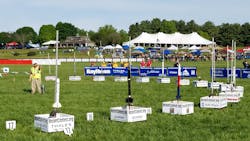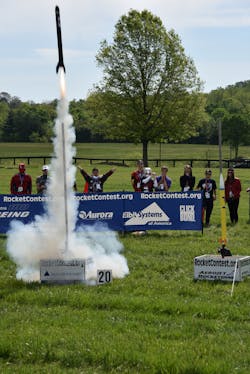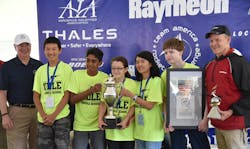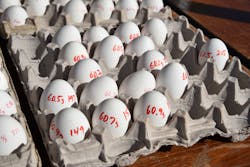More than 5,000 kids, grades 7 through 12, participated in the 2016 Team America Rocketry Challenge (TARC), where they designed, built, tested, and flew model rockets. Sponsored by the Aerospace Industries Association (AIA) and the National Association of Rocketry (NAR), the 2017 competition will mark the 15th anniversary of TARC. The competition aims to excite and educate youth about rocket science and engineering, as well as build a stronger U.S. workforce in STEM.
One hundred teams are chosen to participate in the national competition, which takes place in Great Meadow in the Plains in Virginia, approximately a 1-hour drive from Washington DC. There, rockets are launched with a very delicate payload—a raw egg—at least 850 feet into the air and have to land safely within a window of 44 to 46 seconds. The egg may be padded or packaged to protect it from breaking, but must be able to be removed from its casing for inspection by officiators. Over $100,000 in scholarships is awarded to the top 10 winning teams before moving onto the international competition in London on July 15.
The first-place TARC champions from 2016 are members of the Space Potatoes team from Odle Middle School in Bellevue, Washington. The team was awarded over $20,000 in scholarships and funds for their school, and will move on to the international competition. The Space Potatoes’ combined score of 13.25 surpassed the 2015 champion team’s final tally. Click here to view more results from the 2016 competition.
National-Competition Rules
Teams selected to participate in the competition must build their rockets based on NAR’s Model Rocket Safety Code. All rockets must also obey local fire and federal aviation regulations. Furthermore, participating teams have to also adhere to engine-power limitations and follow a standard model when building their rocket. These and other rules are specified in the official rules for 2017. Electrical launch systems and launch pads are provided by the event officials at the competition, but teams can opt to use their own system.
Registration for next year’s competition begins on September 1 and ends on December 2. Teams may come from schools or homeschools, or from U.S.-incorporated non-profit youth and educational organizations. Questions can be directed to [email protected].
Resources
Full participation in the competition requires intensive research and understanding of the rules by each team. TARC has a range of learning resources on its website about the physics and math of rocket science, as well as view guides on how to build a performing rocket. Included are a video describing the parts and function of model rockets; a Beginner’s Guide to Model Rocketry by NASA; and a 3-part video series titled “So you want to be a Rocketeer” that discusses the basics of rocketry. In addition, an extensive article authored by Tim Van Milligan of Apogee Components helps teams design their rockets.
Although teams are required to build their rockets without outside help from adults, educators and teachers are encouraged to aid participants in their education of rocketry and standard engineering principles. That said, the page also includes resources for educators. NAR’s educational resources enable teachers and youth leaders to assist teens in learning rocket science principles; further resources include those from NASA’s Marshall Space Center, Estes model rocketry, and other rocketry organizations. Educators can also benefit from model rocketry curriculum, student handbooks, and literature for teaching laws of motion, aerodynamics, and rocket stability.
Developing Professional Engineering Practices
In addition to building skills in math, physics, and aerodynamics, the program aims to prepare kids for careers in STEM by subjecting them to formal standards and engineering practices in a fun and competitive atmosphere. Teams participating in TARC also have the option to sign up for the Engineering Notebook challenge.
Team notebooks are judged based on their design-cycle documentation, from initial brainstorming and proof-of-concept to final design and operational specifications. Documentation should enable other designers to successfully reproduce the work done by the team. Students are required to follow basic practices when creating their design process notebooks, which includes crossing out errors to avoid potential intellectual-property disputes; using a hardbound, rather spiral-bound, notebook; using pen rather than pencil; and dating all entries. Winners of the notebook competition will receive a plaque and a cash prize.
About the Author
Leah Scully
Associate Content Producer
Leah Scully is a graduate of The College of New Jersey. She has a BS degree in Biomedical Engineering with a mechanical specialization. Leah is responsible for Machine Design’s news items that cover industry trends, research, and applied science and engineering, along with product galleries. Visit her on Facebook, or view her profile on LinkedIn.



